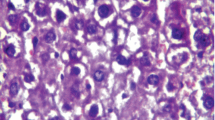Abstract
Series of female virgin and pregnant albino mice were i.v. injected with14C-labelled- or unlabelled toxaphene (16 mg/kg b.w.). After survival times ranging from 1 min to 32 days the toxaphene distribution in the body was studied using whole-body autoradiography and capillary gas-chromatography. Autoradiographic studies have shown that after an initial accumulation in the liver, brown fat, lung, brain, kidney, and ovaria (corpora lutea) there was a gradual redistribution of radioactivity to the white fat within 4 h postinjection. The labelling was then decreasing rapidly and only negligible amounts of the radioactivity were present in the adipose tissue after 32 days. In the fetus only the liver and adrenals showed a distinct labelling. A specific and persistent accumulation of the label was detected in some zones of the adrenal cortex suggesting a possible direct interference of toxaphene with adrenal steroid hormone synthesis. The gas chromatographic pattern of toxaphene-derived residues in the tissue samples resembled that of the technical toxaphene, but was changing in different tissues with the time. The liver chromatograms indicated more extensive formation of metabolites.
Similar content being viewed by others
References
Appelgren LE (1967) Sites of steroid hormone formation. Acta Physiol Scand (Suppl) 301: 1–108
Berndt S, Nakagawa A und Schwabe U (1967) Die Speicherung von p,p′-DDT und o,p′-DDT in der Nebenniere und ihre Bedeutung für den Stoffwechsel von Corticosteron und Cortisol. Arch Pharmakol Exp Pathol 256: 383–396
Bidleman TF and Olney CE (1975) Long range transport of Toxaphene insecticide in the atmosphere of the western North Atlantic. Nature 257: 475–477
Biessmann A, Mohammed A and Slanina P (1983) Studies on the tissue disposition and fate of14C-toxaphene in Japanese quail. Toxicology (in press)
Brandt I (1977) Tissue localization of polychlorinated biphenyls. Chemical stucture related to pattern of distribution. Acta Pharmacol Toxicol (Suppl) II 40: 1–108
Brandt I, Lydén A, Slanina P and Albanus L (1980) Hexachlorobenzene (HCB) and some of its sulfur-containing metabolites: tissue retention and excretion routes in mice. In: Holmstedt B (ed) Mechanisms of toxicity and hazard evaluation. Elsevier/North Holland Med Press, pp 627–630
Bäckström J, Hansson S and Ullberg S (1965) Distribution of C14-DDT and C14-dieldrin in pregnant mice determined by whole-body autoradiography. Toxicol Appl Pharmacol 7: 90–96
Casida JE, Holmstead RL, Khalifa S, Knox JR, Ohasawa T, Palmer KJ and Wong RY (1974) Toxaphene insecticide: A complex biodegradable mixture. Science 183: 520–521
Chandurkar PS and Matsumura F (1979) Metabolism of toxaphene components in rats. Arch Environm Contam Toxicol 8: 1–24
Crowder LA and Dindal EF (1974) Fate of36Cl-toxaphene in rats. Bull Environ Contam Toxicol 12: 320–327
Durkin PR, Howard PM, Saxena J, Lande SS, Santdonato J, Strangl JR and Christopher DH (1980) Reviews of the Environmental Effects of Pollutant: X Toxaphene. National Technical Information Service (USA) ORNL/EIS-130
Holmstead RL, Khalifa S and Casida JR (1974) Toxaphene composition analysed by combined gas chromatography-chemical ionization mass spectrometry. J Agr Food Chem 22: 939–944
Inao S (1970) Adrenocortical insufficiency induced in rats by prolonged feeding of Kanechlor (chlorobiphenyl). Kumamoto Med J 23: 27–31
Jansson B, Vaz R, Blomkvist G, Jensen S and Olsson M (1979) Chlorinated terpenes and chlordane components found in fish, guillemot and seal from Swedish waters. Chemosphere 8: 181–190
Jansson B (1980) Separation of toxaphene components. National Swedish Environment Protection Board, Internal Report
Jensen S, Reutergårdh L and Jansson B (1979) Analytical methods for measuring organochlorines and methyl mercury by gas chromatography. In: Seventh FAO/SIDA Workshop on Aquatic Pollution in Relation to Protection of Living Resources, May 7–June 9, 1979), Workshop Manual, Part 3. FAO Technical Paper FIR: TPLR/79/4 Manilla, Philippines
Kupfer D and Bulger WH (1976) Interactions of chlorinated hydrocarbons with steroid hormones. Fed Proc 35: 2603–2608
Lackey RW (1949) Observations on the acute and chronic toxicity of toxaphene in the dog. J Ind Hyg Toxicol 31: 117–120
McGee LC, Reed HL and Fleming JP (1952) Accidental poisoning by toxaphene. J Am Med Assoc 49: 1124–1126
Nelson AA and Woodard G (1949) Severe adrenal cortical atrophy (cytotoxic) and hepatic damage produced in dogs by feeding 2,2-bis (parachlorophenyl)-1, 1,-dichloroethane (DDD or TDE). Archs Pathol 48: 387–394
Ohsawa T, Knox JR, Khalifa S and Casida JE (1975) Metabolic dechlorination of toxaphene in rats. J Agr Food Chem 23: 98–106
Pollock GA and Kilgore W (1980) Excretion and storage of (14C) toxaphene and two isolated (14C) toxaphene fractions. J Toxicol Environ Health 6: 127–140
Reuber MG (1979) Carcinogenicity of toxaphene: A review. J Toxicol Environ Health 5: 729–748
Saleh MA and Casida JE (1977) Consistency of toxaphene composition analysed by open tubular column gas-liquid chromatography. J Agric Food Chem 25: 63–68
Saleh MA and Casida JE (1978) Reductive dechlorination of the toxaphene component 2,2,5-endo,6-exo,8,9,10-heptachlorobornane in various chemical, photochemical, and metabolic systems. J Agric Food Chem 26: 583–590
Saleh MA, Skinner RF and Casida JE (1979) Comparative metabolism of 2,2,5-endo,6-exo,8,9,10-heptachlorobornane and toxaphene in six mammalian species and chickens. J Agric Food Chem 27: 731–737
Sundström G (1981) Toxafen i svensk miljö — tillförsel via luftnedfall (Toxaphene in the Swedish environment-transport via aerial fall-out). In Organochalogener og akvatisk miljø. Nordforsk, Miljövårdserien Publikation 1: 331
Ullberg S (1954) Studies on the distribution and fate of S35-labelled benzyl(penicillin in the body). Acta Radiol (Stockholm suppl) 118: 1–110
U.S. Environmental Protection Agency (EPA) (1982) Toxaphene; Intent to cancel or restrict registrations of pesticide products containing toxaphene. Fed Reg 47: 53784–53793
Wideqvist U, Jansson B, Reutergårdh L, Sundström G and Uvemo U-B (1982) The evaluation of a gas chromatographic method for the analysis of toxaphene. Swedish Environmental Protection Board Report 82-01. Wallenberg Laboratory, 105 91 Stockholm, Sweden
Zell M and Ballschmiter K (1980) Global occurrence of hexachlorobenzene (HCB) and polychlorocamphenes (Toxaphene) (PCC) in biological samples. Fresenius Z Anal Chem 300: 387–402
Author information
Authors and Affiliations
Rights and permissions
About this article
Cite this article
Mohammed, A., Andersson, Ö., Biessmann, A. et al. Fate and specific tissue retention of toxaphene in mice. Arch Toxicol 54, 311–321 (1983). https://doi.org/10.1007/BF01234484
Received:
Issue Date:
DOI: https://doi.org/10.1007/BF01234484




